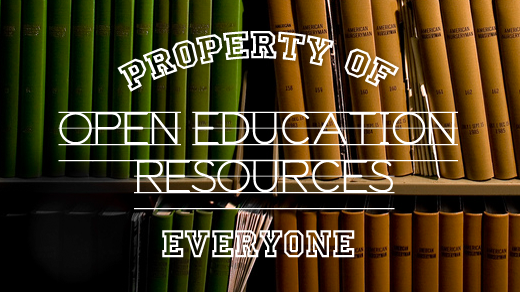Despite the attempts at single sentence definitions so common in the published literature, “open educational resources” is a highly context-mediated construct. However, because philanthropic and public funding agencies commonly require grant outputs to be open educational resources, the ability to quickly and clearly categorize a variety of creative works as “open educational resources” or “not open educational resources” has become critical.
Many funding agencies and programs that require OER simply require grantees to apply a Creative Commons license to their grant outputs (e.g., the William and Flora Hewlett Foundation, the U. S. Department of Labor, the Washington State Board of Community and Technical Colleges, etc.) in order to meet the “open educational resources” requirement.
From a grant or contract compliance standpoint, the operational definition of open educational resources is often collapsed to:
Open educational resource, (n). Any artifact that is either (1) licensed under an open copyright license or (2) in the public domain.
An “open copyright license” is an irrevocable copyright license which grants the following permissions to everyone at no cost: permission to reuse the artifact (e.g., publicly display or perform), permission to copy and redistribute the artifact (e.g., share), permission to revise the artifact (e.g., translate or localize), and permission to remix the artifact with other artifacts (e.g., mashup or collage). This grant of permissions may come with restrictions. For example, a license may restrict these permissions to (1) those who agree to attribute the author of the OER when exercising the permissions, (2) those who agree to relicense any derivative works based on the OER under precisely the same license, or (3) those who agree to exercise the granted permissions in only noncommercial ways. The Creative Commons BY, BY-SA, and BY-NC-SA licenses are examples of open licenses.
“In the public domain” means that, while the nature of the artifact qualifies it for copyright protection, the artifact is not subject to copyright restrictions.
A benefit of defining an “open educational resource” in terms of copyright status is that the definition implies that all OER belong to the universe of copyrightable things. This explicitly precludes ideas, concepts, methods, people, places, events, and other non-copyrightable entities from being OER. (This helps us avoid some of the nonsense that went on with “learning object” definitions.)
For many high-level purposes this definition may be sufficient. However, there is a significant amount of nuance hiding beneath this quick-and-dirty definition. While adopting a blunt definition of OER may be common practice, understanding the underlying nuance would likely be valuable. One way of exploring this additional meaning is asking, “What would the ideal OER look like?”
The Ideal OER
Considering what the “ideal” open educational resource would look like might give OER producers (whether lone or collaborative, student or teacher, etc.) a clearer view of what their OER designs should aspire to. However, the notion of an “ideal” open educational resource begs the question “ideal in what way?” Ideal for helping every person in the world attain all the education they desire? Ideal for insuring that taxpayers realize the maximum benefit possible from publicly funded programs? Ideal for maximizing PR and good will for your institution? Ideal for destroying the commercial educational publishing industry? There are likely as many reasons for sharing OER as there are individuals and institutions engaged in sharing. Consequently, every community, individual, or institution’s ideal OER will be different, and it is important that we pause and acknowledge this.
Below, I work from the position that “an ideal OER would help every person in the world attain all the education they desire.” In this specific context, I believe the ideal OER would have three characteristics. It would:
1. Be always, immediately, and freely accessible by every person in the world
2. Grant the user the legal permissions necessary to engage in each and every possible usage of the resource with no restrictions whatsoever
3. Effectively support the educational goals of the user
Let’s discuss each of these characteristics in detail.
The access ideal is not realizable in practice. There is no single technology or method, or combination of technologies or methods, that can always provide each and every person in the world with immediate, free access to any resource.
The notion of access, and whether or not a specific OER is accessible, is highly context-dependent. This context dependence makes the inclusion of “accessible” as a criterion in a definition of OER unsavory if the purpose of the definition is to help people sort resources into OER / not-OER categories. However, as an ideal that OERs should absolutely strive for, it’s worth understanding the complexities involved. But let’s explore it the other way, and assume for a moment that “is accessible” in included in the basic definition of OER. What happens?
If a digital artifact released under a CC BY license is posted on a public website it would qualify as an open educational resource for everyone with internet access. However, if a teacher downloaded a copy of the OER and placed it inside a learning management system it would suddenly cease to be an open educational resource – even though the resource hadn’t changed. Likewise, a printed book released under a CC BY license and housed in a public library would be an open educational resource. However, if this exact same book were moved to a high school library that requires an ID prior to admission, it would cease to be an open educational resource.
Note, however, that a student with access to the high school library and enrolled in the class using the LMS still has access to these materials, so those copies of the resources simultaneously are OER to her while they are not an OER for others. In fact, regardless of its design and license, every resource that qualifies as an OER for someone disqualifies from the perspective of someone else. Pushing this thinking to its logical conclusion, none of the artifacts from the previous examples are an OER to a man living on a desert island without internet connectivity, because he has access to neither the web nor the library.
Thus we see that the inclusion of “access” in a basic definition significantly would significantly confuse the matter of categorizing resources in a general-purpose manner, because the access question must always be answered by an individual. However, as an ideal worth striving toward, understanding the issues involved in increasing (or accidentally decreasing) access is critical.
The licensing ideal is realizable. Placing a resource in the public domain realizes the permissions ideal. Open licenses approximate the ideal by providing free 4R permissions to users of OER together with requirements that may or may not be overly onerous, depending on the restrictions chosen and the individual’s context.
The efficacy ideal is not realizable in practice. Intuitively we would want the ideal OER to support the educational goals of every user, and some definitions limit OER to “high-quality” materials. However quality, like beauty, is in the eye of the beholder. A resource considered very high quality by an English speaking undergraduate might be very low quality for an English speaking primary school student or a Spanish speaking undergraduate. Requiring an OER to be “high quality” creates a situation in which every openly licensed artifact in the world is simultaneously an OER to someone and not an OER to someone else. While everyone wants the OER they use to be high quality for them, it is meaningless to talk about OER being “high quality” without simultaneous reference to the user. Consequently, while efficacy is an ideal we should strive for, efficacy itself cannot be included in a definition.
Some definitions limit OER to materials useful for teaching, learning, and research (e.g., Hylen (2006) or Atkins, Brown, and Hammond (2007)). These limitations, while seemingly reasonable, exclude nothing in practice. What photograph could not be made to serve a teaching, learning, or research purpose? What sound recording could not be made to serve a teaching, learning, or research purpose? What video could not be made to serve a teaching, learning, or research purpose? &c. In addition to excluding nothing, the “useful for teaching, learning, and research” restriction makes little sense in the context of the growing importance of informal learning.
Some definitions limit OER to “digital” or “web-based” materials. More narrowly, some definitions limit OER to materials that are made available in open file formats. Both these restrictions exclude the possibility of non-digital (e.g., printed) OER, which are an extremely important subset of OER (e.g., for use in disconnected parts of the world). While providing OERs in an editable, digital format provides important benefits to many users, it prohibits others from using OER. Consequently, while the digital issue should be carefully considered, a digital requirement for OER does not make sense.
Perhaps the key takeaway from this entire discussion is that much of what makes an OER ideal is context specific – ideal to whom, for what purpose, to be accessed in what way, to be used in what fashion, etc. The only ideal attribute realizable in practice, across all individuals in all contexts, is the licensing ideal. I believe this is why when-push-comes-to-shove definitions of OER (like those included in grant requirements) rely solely on the licensing requirement as their categorization scheme. And that’s probably a good thing. Beyond public domain dedications or open licensing, OER producers (whether self-organizing communities, individuals, or institutions) need to be free to make their own decisions along the axes of access, efficacy, digital, etc. in order to best achieve the aspirations that prompted them to develop OER in the first place.
This article was originally published on Iterating Toward Openness and reposted with the author's permission.







2 Comments